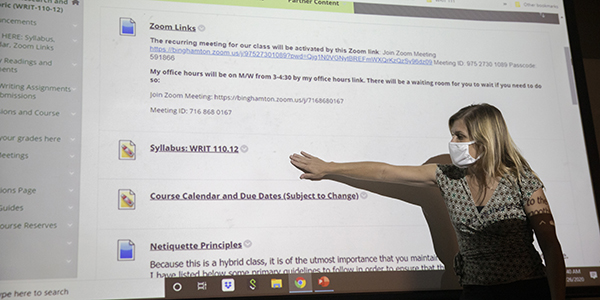Making remote instruction more engaging
Additional camera and audio systems aid interactivity for remote teaching

With the quick transition to remote learning in spring 2020, Binghamton University implemented a number of measures to improve the remote learning environment for fall 2020. Now, additional upgrades have been made for spring 2021, again centered on making instruction more engaging and interactive for all students, and user-friendly for instructors.
“We conducted surveys about student and faculty experiences with online learning and instruction,” said Paula Russell, senior director of the Center for Learning and Teaching. “The campus listened very carefully to both faculty and students about what could make their campus teaching and learning experiences better and safer during the pandemic.”
It’s important to show the campus is responsive to student concerns, Russell noted. “Over the past several years we’ve been working diligently with the instructional design staff to provide an environment and pedagogies that promote active, engaged learning.
“Recent student and faculty survey responses told us that, especially when teaching and being taught in Bingflex mode with some students in person and some on camera, it was challenging to orchestrate conversation happening in the chat and in Zoom as well,” she said.
The feedback prompted technology upgrades to five classrooms.
“Two of these rooms (LH-8 and LH-14) now feature camera systems that will specifically allow faculty to capture writing surfaces in the room,” said Andrew Tucci, director of Educational Communications. “For example, we noticed a real concern with math-based instruction during the fall semester, because it’s hard to transition the ‘large writing surface’ rooms into a remote environment. We now have cameras that can shoot all of the boards in these rooms, allowing the instructors to work their way around the room and still capture that experience for online students.”
“These cameras also allow different angles and close-up shots to improve the experience for everyone in the class,” Russell said.
Three other rooms (AA-G007, CW-112 and CW-114) were upgraded with full microphone systems and higher-end audio processors, Tucci added. “These upgrades allow for in-room students and online students to converse in real time.
“Discussion-based classes had been struggling to experience the same level of class discourse that they had when all students were in the classroom,” Tucci said. “By outfitting these rooms, professors can closely recreate that same ‘everybody together’ experience of semesters past, even when one group of students is online and another is in-room.”
The majority of classrooms are now where we need them to be, Russell said. “We have a seven-year cycle we go through for refreshes and upgrades. The pandemic has accelerated that schedule in some areas, but the footprint of classrooms on campus is huge, and having a cycle and informing that cycle is important,” she said. “We wouldn’t have anticipated the rapid migration to remote instruction four years ago, but now online instruction is paramount.”
“Investing in these technologies underscores Binghamton’s commitment to offering the best educational experiences for our students, no matter the circumstances,” Tucci said.
In addition to the technology upgrades, about 175 Classroom Technology Assistants (CTAs) will continue to assist faculty with the technology necessary for teaching remotely and in a hybrid manner in the spring semester.
“The CTAs were a huge assist to faculty in the fall,” Russell said. “They take the technical concerns out of the experience so instructors don’t have to pay attention to muting, and chat in terms of Zoom, but also when there are presentations that require projection so in-room and remote students can view them.
“We do our very best to prepare, anticipate and feel confident that we’re structured to be successful,” Russell said. “One of the things we’re doing is trying to become more nimble so we can pivot quickly. In some cases, we have to wait for the actual classroom space to be available to make the upgrades, other times it’s resources. If we had a money tree, we’d be there with our buckets filling up!”
Training in how to use the technology is available to faculty and the CTAs, including recorded trainings for those unable to make in-person sessions and room-specific orientations for those assigned to the upgraded classrooms. “We also work with the University Center for Training and Development and Information Technology Services and provide just-in-time support.”
And finally, Russell said instructors shouldn’t feel they have to use every bit of new technology the first day.
“Try and get used to it and if you get stuck, we’re here for you,” she said.

